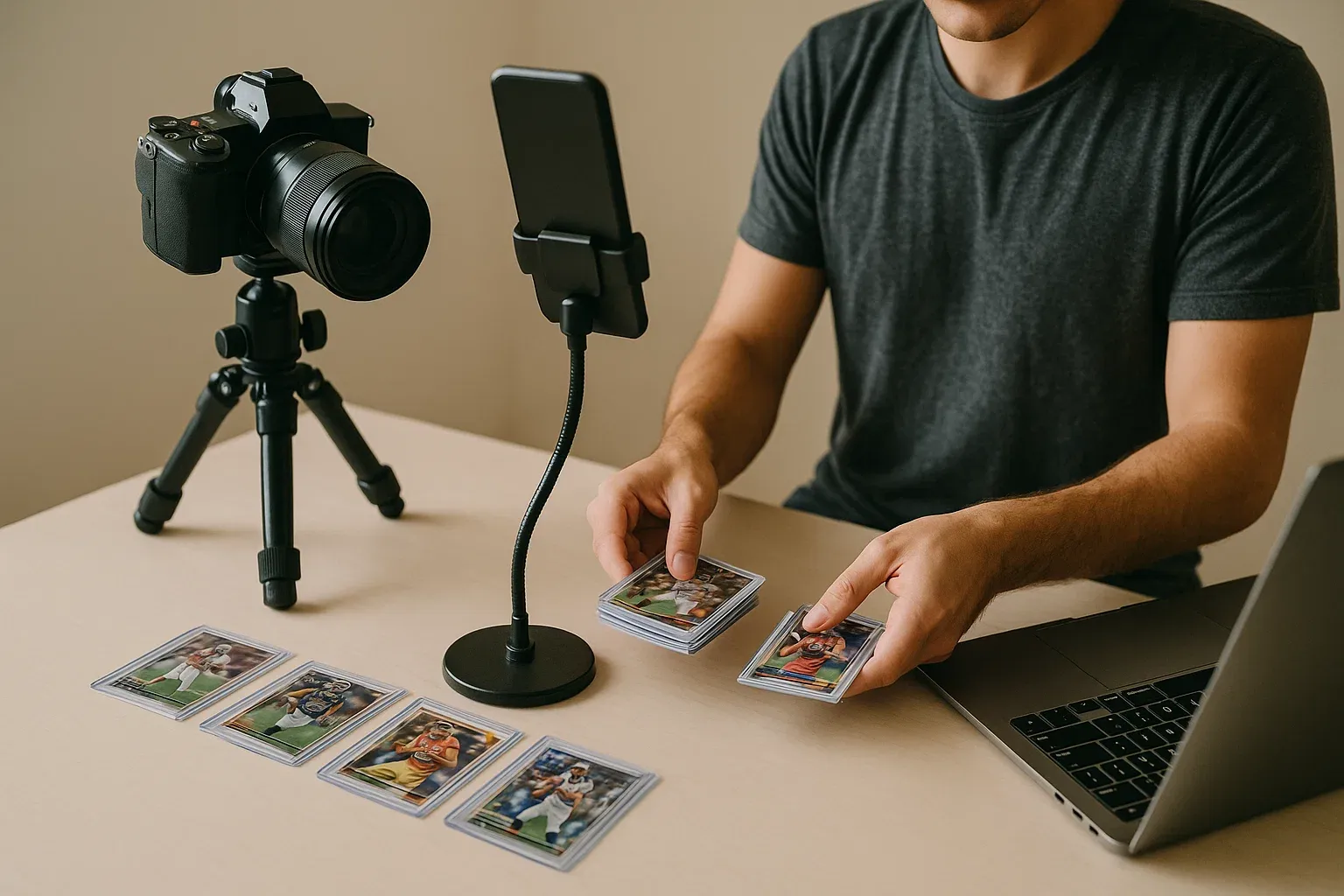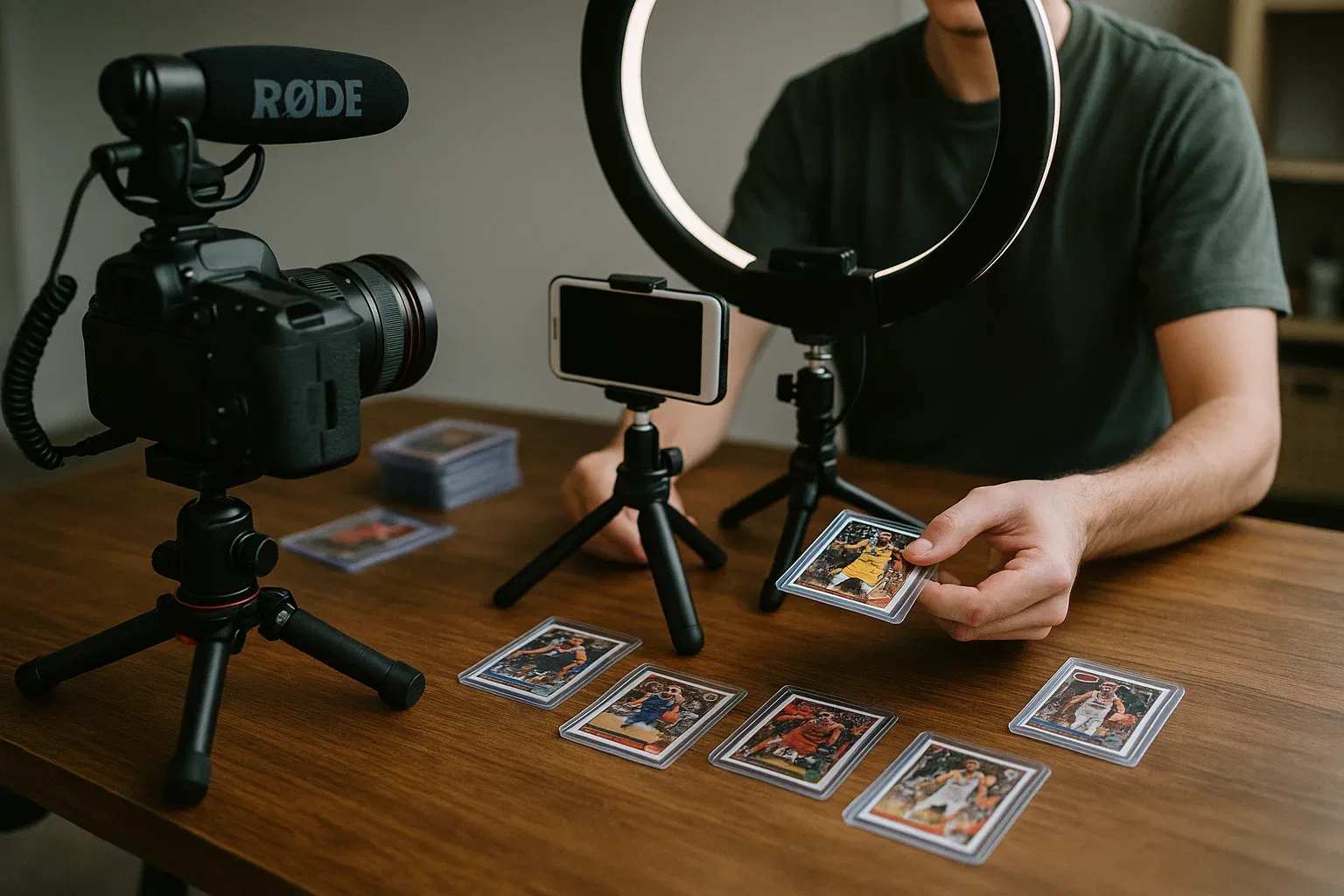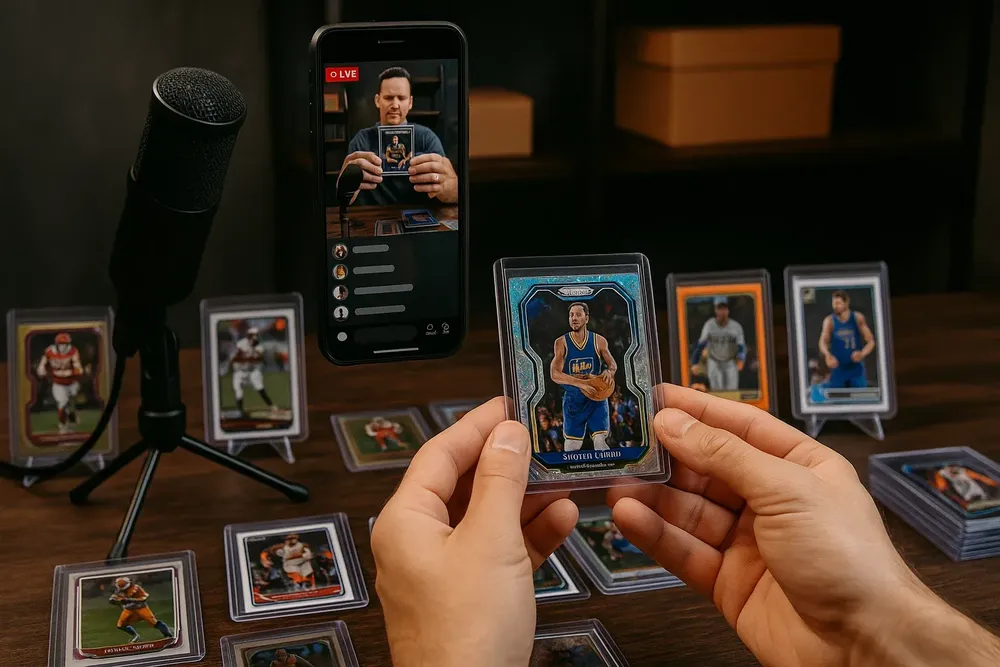How to Start a Sports Card Break Business on Whatnot
Thinking of selling sports cards on Whatnot? This guide explains how to start a card break business, set up your stream, build trust, and avoid common mistakes.
Understanding Sports Card Breaks

A sports card break means opening sealed boxes of cards live, selling spots that grant buyers a share of the cards pulled. Box and case breaks divide products by teams, players, or random assignment. Buyers can pick a team or accept a random draw. Top break formats include:
- Pick Your Team: Buyers pick from available teams before the break. Teams with top prospects are costlier.
- Random Team: Buyers purchase a spot and receive a team through software or on-stream spin.
- Hit Draft: Each spot is assigned a draft order. After opening, buyers choose cards in sequence.
- Mini Break: Lower-cost breaks with smaller products or packs, usually to give newer buyers an entry point.
Each break format suits different buyer groups and has its own requirements for fairness and transparency.
Building a Loyal Customer Base for Sports Cards Break Business on Whatnot

Earning repeat buyers is tied to visible fairness, clear branding, and thoughtful perks. Consistency is vital; using the same logos, card mats, and backdrop each time can increase mental recall by 40 percent compared to generic setups from different streams. Always keep every card, your hands, and the break area within the camera frame. Whatnot's own requirement is full visibility for accountability and dispute avoidance. If even one part of the process is hidden, buyers are 89 percent more likely to distrust the stream, which erodes future sales.
Provide detailed checklists for each product, including what inserts, autographs, or numbered cards could show up. Buyers stay for information and leave if the process is vague. Many top breakers run Q&A rounds, explain odds, or discuss previous big pulls, which boosts engagement by around 18 percent per month.
Rewards work, but only if they are straightforward. Simple loyalty bonuses, like "buy 10, get 1 free," or point-based perks redeemable for exclusive breaks, increase return rates by 15 to 20 percent. Thank-you notes and next-day shipment can raise repeat purchases by 32 percent. Transparency also means rules must be visible before any buyer commits funds.
Common Mistakes to Avoid for a Sports Cards Break Business

Most failed card break businesses suffer from a few repeat issues:
- Poor streaming quality: Over 70 percent of breaks that lose participants early have slow upload speed or bad audio. A poor camera setup leads to accusations of scamming if cards go off-screen or become blurry. Always check your equipment before each session and monitor the bitrate during streaming.
- Overpriced spots: New sellers charge as much as 40 percent over average spot rates compared to benchmarks like BREAKCOMP. Overpricing means unsold spots and customers who never return. Always double-check current spot values for your box or case. Avoid rapid price hikes when others undercut you.
- Hidden shipping costs: Tacking on shipping at checkout leads to higher cart abandonment. Instead, include a flat rate in the spot price. Shipping buried in spot prices lowers drop-off by about 18 percent.
- Pre-selling outside Whatnot: The platform bans offsite presales. Sellers holding unpaid or presold spots off-platform risk instant suspension once reported. Whatnot monitors for this and acts promptly.
- Unclear rules: Failing to post the break's rules in the show notes causes confusion and refund claims. Always state everything up front. If the rules are vague, refund rates climb by nearly half.
Essential Equipment for Sports Card Breaks Business on Whatnot

Equipment quality is a key factor in customer retention and accusation avoidance. Here is a breakdown of what works in current market conditions:
- Video Setup: A 4K or at least 1080p webcam shows all cards clearly. Dual-camera setups help prevent scams and improve trust by offering different angles, especially showing both hands and cards at once. Ring lights reduce glare and shadows.
- Audio: A USB-powered microphone captures clear commentary. Poor audio drives off viewers faster than bad video. Microphones in the $100 to $150 range are preferred by most full-time breakers.
- Internet: Wired connections are better than Wi-Fi. Upload speeds of 10 Mbps or more reduce lag and abrupt disconnects.
- Break Mats and Backdrop: A branded anti-slip mat keeps cards organized. Custom mats, sized about 31 inches by 15 inches, cost between $89 and $150 but pay off in professional appearance and fewer damaged cards. Backdrops decorated with your business brand or logo help solidify a presence.
- Sorting and Handling: Penny sleeves and hard top loaders protect hits during and after the break. Always use gloves or sanitize your hands to prevent fingerprints and damage.
- Shipping: Padded mailers, team bags, bubble wrap, and thermal label printers streamline packaging and reduce the chance of injury to high-end cards. Use a digital scale and online postage tools to avoid under- or overcharging.
- Software: OBS Studio or Streamlabs can run your stream with overlays and randomizations. Whatnot Breaks Manager has built-in randomization and batch spot generator, which saves setup time by about 80 percent for large breaks.
Starter bundles containing mats, stickers, and branded gear typically cost $349 for new sellers, which reduces open disputes by improving visible professionalism and organization.
Pricing Your Sports Card Breaks for Profit
Correct pricing starts with clear math. You need to cover all direct costs (product, supplies, fees, expected shipping) and build in a profit margin that does not scare away buyers. The cost-plus model is common. Add up:
- Box/case purchase cost
- Shipping materials (average of $2 per buyer)
- Platform fees (Whatnot takes about 8% of sales plus processing fees)
- Estimated taxes
- Desired profit, usually 10–20 percent per break
Divide by the number of spots. For example, if a $200 box has 10 spots, $20 covers the box. Add $2 for shipping, $2 for fees, and $3 for profit — each spot would be $27.
Spot prices for high-end teams in "Pick Your Team" breaks routinely run 2 to 2.5 times higher than base rates for less-desired teams. Premiums are justified for teams with popular rookies or high-value veterans. For super-premium products, like Topps Transcendent, single spots can reach above $400. Know your audience and what they will pay, then check current comps for every type of product.
Auction or game-based spot sales, such as "Spin 3, Pick 1," bring in a 22 percent higher average sale than fixed-price listings. If using this approach, keep games simple and always explain the rules before starting.
Legal Considerations
Sports card breaks walk a legal line in many areas. Key factors buyers and sellers face in the United States include:
- Gambling Laws: Some random breaks are considered gambling in nearly 40 percent of the country. Using a hit draft or guaranteeing a set card per spot helps avoid this. Avoid language like "raffle" and never add unrelated items, like memorabilia, to card-only breaks on Whatnot.
- Income Reporting: The Internal Revenue Service now tracks all sellers with $600 or more annual earnings on third-party platforms. You must provide your tax identification for a 1099-K at year's end and pay self-employment as well as regular taxes. If your volume tops 200 transactions, new rules classify you as a dealer, which positions you for a possible 28 percent collectibles tax (as of 2025).
- Break Rules and Platform Policies: Whatnot sets strict internal rules. Sellers may not allow household members to buy into breaks, cannot sell off-platform spots, and must finish breaks in one stream. Failure usually gets an account suspended within a day of the report.
- Recording and Dispute Evidence: Whatnot deletes break videos that are not tagged or labeled as "breaks." Save all VODs locally for legal and tax purposes.
Document and follow every rule. Consult a business accountant with card break and collectibles knowledge if you expect to run a full-time operation.
Marketing Strategies for Card Breaks on Whatnot
Visibility brings buyers. Timing and platform use matter as much as product or price.
- Whatnot Search and Timing: Use strong, relevant keywords in show titles. "Hobby Box" and "Hit Draft" listings receive about 37 percent more impressions. Schedule breaks during peak hours, 7 to 9 p.m. Eastern, when viewers peak by over double. Batch spot generation tools result in about twice as many sold breaks per week because listings are faster to post.
- Cross-Platform Promotion: Share upcoming break times and big hits using Instagram, TikTok, and Discord. Discord communities send about 40 percent more engaged buyers to a stream, especially for new releases or themed breaks.
- Content Snippets: TikTok reels of top pulls, tagged with terms like #CardBreakAlert, increase website traffic by 55 percent the same day. Breakers who also post YouTube highlights, case study streams, or show box-search details outperform those who only stream breaks, earning three times the average follower count.
- Email and Direct Outreach: Collect buyer emails during checkout or after the sale, with permission. An active mailing list sees more than half of recipients return for other breaks, especially after alerts for exclusive runs or sale codes.
- Loyalty and Referral Programs: Perk programs such as "break five times, receive one free spot" or early access for email list members drive both new and repeat sales. Always explain terms clearly.
Never overpromise and avoid artificially inflating card values or odds in promotional content. Most refund disputes trace back to misleading marketing or imprecise product descriptions.
Step-by-Step Guide to Selling on Whatnot

Use this framework to get started methodically:
- Register Your Account: Submit identification, complete an interview if requested, and connect your payment method.
- Set Up Streaming Gear: Connect your camera, lights, microphone, and test for clear video and audio. Position mats, cards, and all supplies on camera.
- List Your Breaks/Products: Select the right category, name products with specific details, and use Whatnot templates or batch spot generator for ease.
- Announce the Break: Share your scheduled stream across social media and your email list. State all break rules and what's included.
- Run the Live Break: As spots fill, assign teams or spots clearly, pin results, and recap rules before opening any seal. All cards and hands must remain visible.
- Ship Cards Promptly: Buyers rate fastest shipping as the highest. Pack with top loaders and ship within 24 to 48 hours. Always post tracking in the order details.
- Follow Up: Thank each buyer publicly or through included notes. Email past buyers about upcoming breaks.
Using these steps, successful sellers run streamlined, compliant, and buyer-friendly operations. Failure to complete even one key part risks refunds, account blocks, or loss of repeat business.
Top Tips for Hosting Successful Breaks
Preparation, consistency, and steady interaction guide every strong break show:
- Product Verification: Show factory seals and serials live to prove product legitimacy. This reduces buyer challenges by about 65 percent.
- Card Handling: Sort and sleeve cards by team or buyer during the break. Organize base, hits, and numbered cards to limit post-break errors. This method reduces sort mistakes by more than 90 percent.
- Interaction: Keep up steady chatter and encourage questions. Mini-games or "stash-or-pass" rounds during downtime keep audiences engaged during slower pulls.
- Order Tracking: Maintain clear on-stream records of hits, using overlays or announce every team's big pulls. Timestamps in VODs help resolve disputes over hits or order of pulls.
- Shipping Timeline: Try to post cards within 48 hours. Ninety-two percent of buyers value quick fulfillment and tracking updates.
- Enforce Rules: Disallow household buying to eliminate the appearance of favoritism. This helps prevent collusion claims, which are a common cause of buyer loss.
Always end each break with a clear recap. This step limits confusion and sets up groups for the next round.
Understanding Different Break Types
Every break format attracts a unique segment.
Pick Your Team breaks appeal to collectors with loyalty to certain teams. These breaks require careful tiered pricing; teams with a key rookie or stars may cost two to three times more. While team-specific breaks draw higher revenue (about 27 percent more than randoms), they take much longer to price, market, and fill each spot.
Random Team breaks provide a more affordable buy-in and appeal to those chasing all types of hits. Use stream randomizers on camera to avoid disputes.
Hit Drafts guarantee each buyer at least one card. Assign draft order using live randomization, then allow each slot to pick hits in turn. This format appeals to high-end box buyers, often drawing more serious spenders willing to pay $500 or more per slot.
Mini Breaks keep entry fees under $20 and are meant for bulk spots or retail product, attracting new customers on a budget. Sell-through rates are high (above 85 percent) but margins are much thinner.
Case breaks (multiple boxes, high dollar price) require advance marketing but attract experienced buyers. Single-box breaks fill faster and involve less risk for first-timers.
Each type should be described fully before launch. Explain how teams or cards will be assigned, what buyers can expect to receive, and the odds as known from product checklists.
Actual Margin and Revenue Trends in 2024
Profitable break operations run on careful math:
- Top full-time sellers earn between $18 and $23 per working hour after all costs. The highest five percent reach $150,000 or more in net annual income.
- Breakers who negotiate direct deals with product distributors or local card shops secure boxes up to 20 percent below retail cost, doubling profit margins on premium items.
- Shipping insurance, worth 12 percent of total revenue, covers lost packages and dramatically reduces disputes.
- Loyalty programs and cross-promotion lift repeat purchase rates by up to half, especially when combined with quick follow-up and thank-you perks.
The market is dominated by buyers aged 25 to 44, with nearly half spending $500 or more each month on breaks. Livestreamed breaks now cover the clear majority of sports card sales on Whatnot. Participation and revenue track closely with seller responsiveness and visible fairness.
Compliance and Recent Changes
As of 2025, Whatnot enforces stricter rules around stream labeling and video retention. Break streams not clearly tagged face deletion, meaning sellers must save any critical footage before the dispute time windows expire. IRS guidance on collectibles has also narrowed. Crossing 200 transactions per year brings a higher collectibles tax rather than standard capital gains—set aside 28 percent of net profits on inventory if you expect to cross this threshold. Always obtain and retain receipts for all purchases and sales.
Conclusion
Launching a sports card break business on Whatnot means balancing price, fairness, equipment, rule compliance, and buyer engagement. Focus on transparent processes: every hand, card, and randomizer in plain sight. Quality gear, timely shipment, loyalty rewards, and legal compliance are essential for building a club of repeat buyers. Each step, from clear rules to professional setups, raises retention and lifts profit margins. Study current prices, watch competitor streams, invest in professional tools, and do not shortcut rules. This is the best way to gain buyer trust and build a reliable, legal, and profitable sports card break business on Whatnot.
